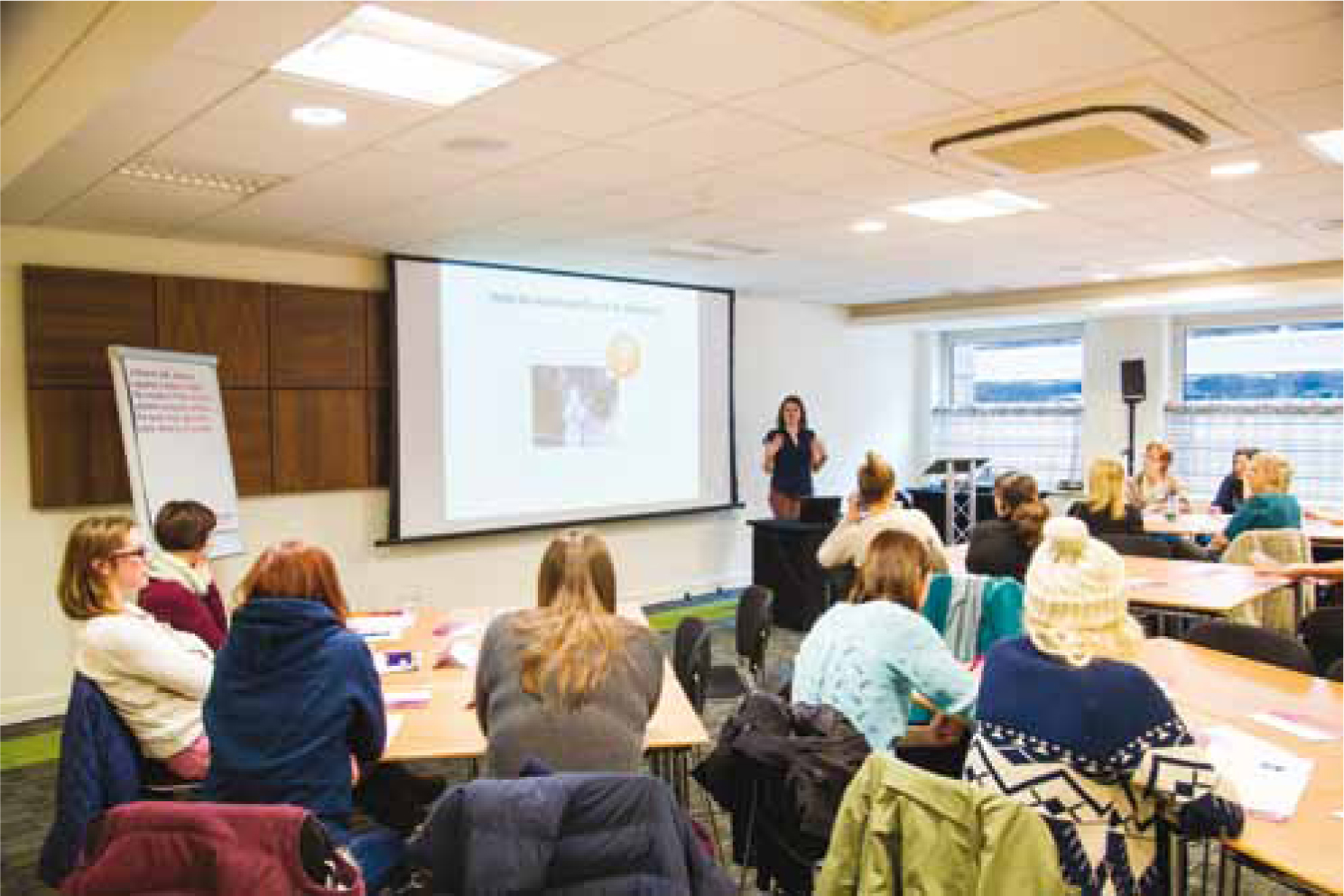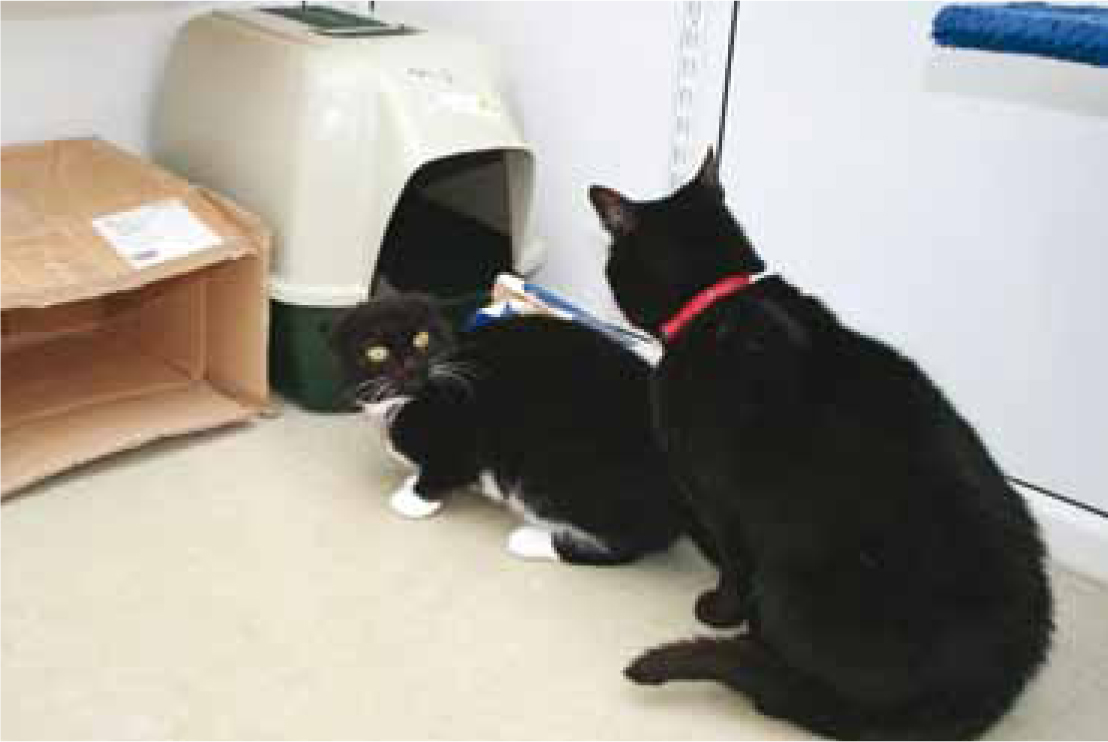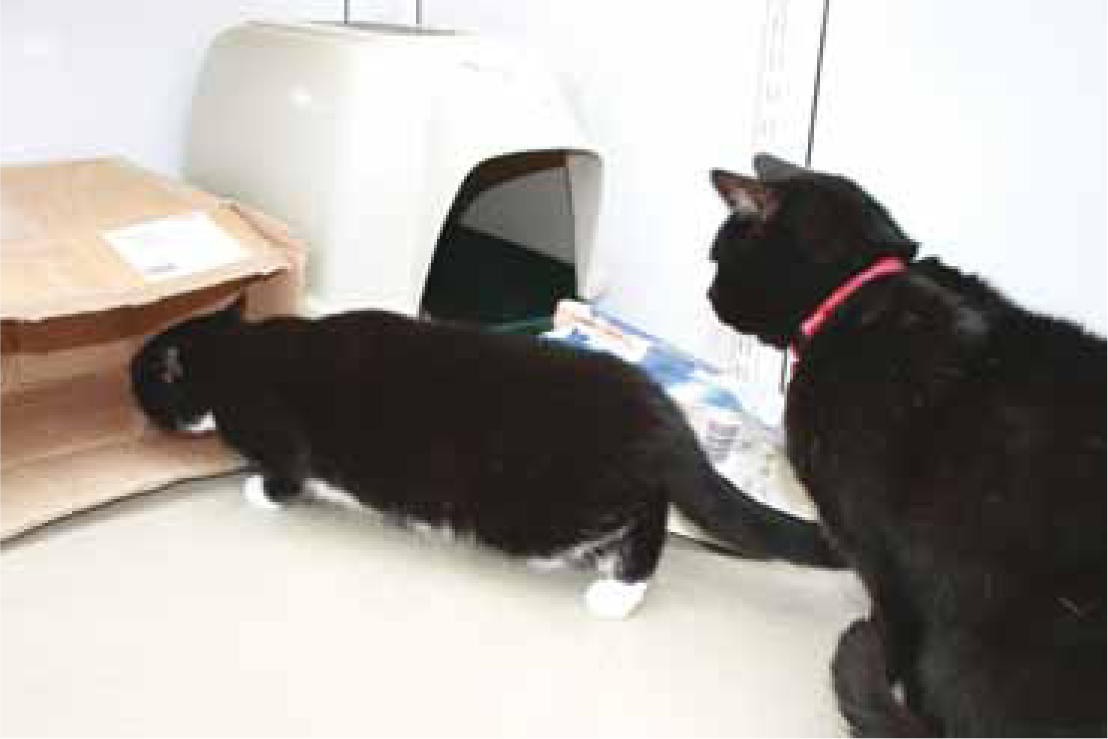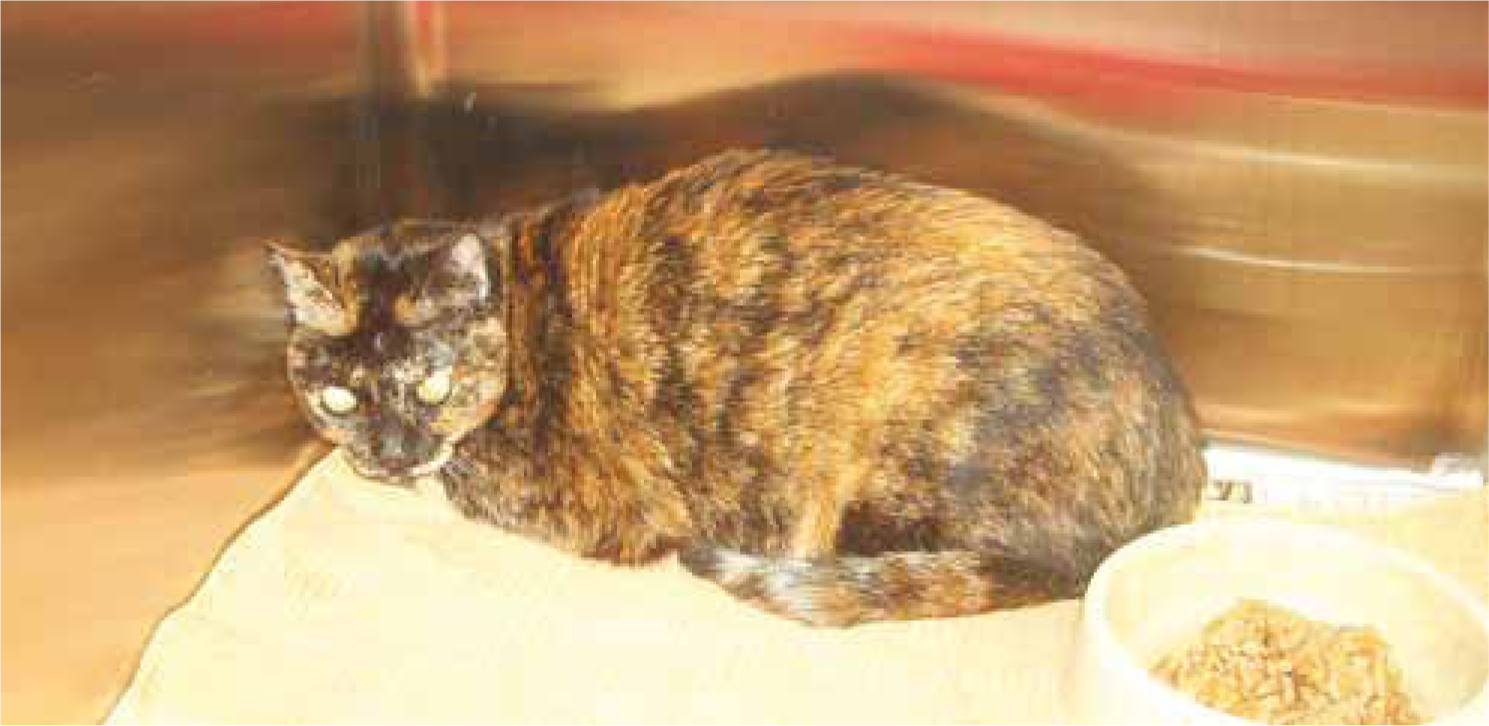It is important that feline stress is considered in cats in the veterinary hospital, as stress can negatively impact on the welfare of the individual in several ways, for example, stressed cat can often be difficult to examine and may require restraint during handling. Such handling can often further impact negatively on the animal's emotional state — such signs of stress related to the veterinary environment and difficulty in examining can make it hard to make a diagnosis. Furthermore, for animals experiencing a stay in the veterinary hospital, stress can increase the recovery time of the patient. It is therefore important to assess each feline patient and take measures appropriate to that individual to help them cope in an inherently stressful environment. As animals descended from a solitary ancestor, cats are often very subtle in their body language and behaviour (e.g. posture, facial expressions, type and frequency of specific behaviours), and as a result signs of stress can be difficult to detect. However, veterinary nurses are well placed to monitor behavioural signs of stress displayed by patients in the hospital. As well as learning such signs, being able to communicate them both verbally and through the use of written records will not only ensure each patient has the best care from nurse to nurse, it will also help any student nurses in the practice learn these skills. Stress in the feline patient was the subject of discussion at The Veterinary Nurse workshops 2015 (Figure 1).

Behavioural strategies witnessed during stressful events
If cats are faced with something stressful, their most common method of alleviating the stress they feel is to create distance between themselves and the stressor, i.e. they use flight. However, their ability to utilise flight in practice may be naturally hindered, for example due to physical restraint through handling, the cat carrier and caging. In such situations, some cats freeze in the hope that the situation will pass. Others may have a quick groom or may busy themselves with sniffing something — a strategy sometimes known as ‘fiddle’. If such strategies do not reduce the feelings of stress, nor remove the stressor, a cat may then resort to fight. Cats which adopt this strategy in practice can be difficult to diagnose and treat appropriately as examination is so difficult. Furthermore, some cats can become confident in their use of aggression, i.e. other behavioural strategies have not been successful at reducing or removing stressors previously, so are likely to opt to use aggression first in similar situations. Often these cats become the ‘nightmare’ cats that practices do not look forward to dealing with — they have learned to use aggression. In extreme cases, some give no warning hisses or growls and go straight to biting or swiping. Tips to help avoid reaching this point with individual cats are discussed later.
Reading body language
Cats that have had their ability for flight thwarted that resort to freeze often display defensive body language. A defensive cat generally keeps its body tense and close to ground with all four feet on the table (ready to spring to action if it feels the need for flight). Its head is often lowered with whiskers drawn back, ears flattened and rotated, eyes half closed, pupils often dilated and its tail is protectively wrapped tightly close to the body. In some cases, and for some individuals, their fur will be pilo-erect. Intensity of defensive postures can increase as the distance between cat and stressor decreases (e.g. nurse opening and approaching cat in veterinary cage) or in some cases, due to prolonged exposure to the stressor (e.g. lengthy examination or procedure).
Cats displaying defensive postures tend to be very vigilant and therefore will keep their eyes on you at all times. Body language exhibited similar to the defensive cat is that of a cat that is withdrawn, i.e. low to ground, head lowered, whiskers back, tail wrapped closely to body and ears flattened. However, what differentiates a withdrawn cat from a defensive cat is that there is usually a complete lack of eye contact and engagement; the head is commonly pressed closely into the body, the eyes are pressed firmly shut (creases seen at corner of eye), and the head may be orientated towards the corner of kennel or wall. Such cats are relatively non-responsive and as a consequence relatively easy to handle. However, cats using such body language are usually very stressed indeed and attention should be given immediately to reducing stressors to help the cat cope.
In situations of potential conflict, for example a socialised cat who enjoys human company but finds having an injection unpleasant, we often witness specific behaviours. While research has not yet taken place to explain the function of such behaviours (for example are they displacement behaviours? De-arousing function?), they consistently occur in situation of conflict. Such behaviours comprise tongue flick (up, touch nose, back down with no ‘wipe’ of lip), head shake, skin twitching/rippling, exaggerated swallow, short sharp grooming bursts (shoulders, base of tail) and quick scratch behind the ears with hind foot.
Finally, stressed cats may also show offensive postures. Such postures often precede aggression. Some parts of the body are similar to the defensive posture (e.g. eye dilation, muscle tension). However, bodyweight may be forward instead of back, whiskers and ears more likely to be facing forward, legs may be extended so that the cat is standing taller, tail may be extended or partially up rather than tucked under the cat and fur may be piloerect.
While there is still much to learn about coping behaviours in cats, it is important to recognise that the type of behaviours (i.e. flight, freeze, fiddle and fight) and body postures (offensive, defensive, withdrawn and conflicted) (Figure 2 and 3) cats demonstrate when they are stressed may differ between cats due to differing temperament, and may also change within a cat when exposed to different stressors/contexts.


As well as being able to recognise the behavioural signs of stress in the veterinary hospital, it is important to work with owners to teach them to recognise and understand the early signs of stress so that they are able to put into practice stress alleviating measures at home prior to a trip to the veterinary hospital. Prevention is always better than treatment and therefore, veterinary nurses have the opportunity to educate owners about the importance of training cats to cope with the veterinary hospital through a process of desensitisation and positive reinforcement training. This can be carried out initially in the home, for example by training cats that the cat carrier, car travel and a physical examination are nothing to fear and can actually result in positive experiences such as food treats. Such advice can either be via leaflets, videos, or evening meetings. Also, as is often offered by practices for puppies, visits to the veterinary hospital where no procedures or examination occur, but simply a chance to meet the staff and be rewarded with food treats and play should be offered for cats and kittens.
Causes of stress in practice
There are a multitude of potential stressors associated with a visit to or stay in the veterinary hospital — which stressors an individual cat finds stressful depends very much on a number of factors (see later).
Potential stressors in the veterinary hospital:
- Unpredictability — handling, routine, procedures
- Discomfort — from travel, being in cat carrier, from injury or illness
- Novelty — smells, sights, sounds, handling, equipment, sensations (touch), objects, environment, people
- Aversive sensory stimulations — machine noise, medical and disinfectant smells, touch of medical equipment against body
- Lack of control — inability to escape, personal space
- Perceived predators — dogs, cats, people
- Illness/injury — pain.
Evidence for several of these factors causing stress in cats comes from a study by Carlstead et al (1993) — cats that were subjected to irregular feeding and cleaning times, absence of talking or petting by humans (no social interaction) and a daily unpredictable manipulation were found to show higher levels of stress (as measured by both behaviour and physiology) than cats who were maintained on a predictable care-taking routine with positive social (human) interactions. Furthermore, Stella et al (2011) demonstrated that sickness behaviours (e.g. vomiting, diarrhoeas, which can by symptomatic of to a cat feeling stressed) increased if the normal routine changed (e.g. lights on/off at different times from normal, change in person caring for cats). Therefore, the importance of a positive predictable routine and environment should not be overlooked in hospitalised cats.
Why are some cats more stressed than others?
McCune (1994) identified five factors that explained the variation between cats in the first hour of being placed in a cage in a rescue shelter. However, such factors are also applicable to the veterinary hospital:
- Temperament — friendly/bold cats were less likely to inhibit their normal behaviour and less likely to hide compared with unfriendly/timid cats. It is therefore good practice to ask the owners of all feline patients being admitted into the hospital how they would describe the temperament of their cat, to allow for a more accurate assessment of how well that cat copes in the hospital and so that specific measures to help that cat can be implemented. Space for this information could be added in to the admission form along with other information, e.g. cat's food preferences, toy preferences, previous experience of hospital, interaction with humans, allowing nurses to create a cage environment and routine most suited to the individual cat's needs.
- Age — older cats were found to hide less during caging that the younger cats. However, it should be noted that an older cat is more likely to have had previous experiences of caging and if those experiences were negative, this is likely to impact negatively on future caging.
- Travel time — cats were more likely to display a flattened posture (characteristic of threatened cats) if they had had a longer travel time.
- Waiting time — cats that had to wait longer, displayed greater signs of stress.
- Previous experience — this depends on whether previous experience was positive or neutral, as negative previous experience is unlikely to help!
Another study by McCune (1994) explored the influence of paternal genetics and socialisation on a cat's ability to cope with strangers and novel objects — both of which are found in many forms in the veterinary hospital. Results showed that when the novel object was a person the two factors (paternal friendliness/boldness and early handling) interacted so that the friendliest, least distressed cats were those from a friendly father, which had also been socialised for about 5 hours per week between 2 and 12 weeks of age. However, when faced with a novel object, only friendliness of the father had any effect, with cats from friendly fathers being quicker to approach, contact and remain inside novel object as well as exhibiting less defensive behaviour towards the novel object.
Tips to decrease stress in hospitalised patient
Travel
- Cat owners can help to get their cat used to the carrier before travel. When an appointment is booked or in the run up to a visit the practice can give advice to help the owner prepare, e.g. leave cat carrier out, use Feliway spray (Ceva Animal Health) in the carrier, provide rewards in the carrier such as food treats. Such positive experiences will help the cat to perceive the carrier a place of safety for the cat (cats tend to gain safety from places rather than people), protecting against those visits to the veterinary hospital where the cat may experience discomfort.
- Utilise carriers that can have their tops removed so the cat can be examined within the carrier where it will feel safer.
- Cat owners can help their cats cope with travel by placing a blanket over the carrier if the cat finds the moving sights out of the window distressing. They can also train their cats to enjoy travel as you would train a puppy (starting with very short periods of time in the stationary car while receiving rewards such as food treats and building gradually to short trips, again remembering to reward calm behaviour. The cat needs several trips that end in something positive (e.g. a meal back at home) to protect against those times the trip ends at the vets. During this training, it may be necessary to have a passenger in the car to deliver the food treats.
Waiting room
- Spray blankets daily with Feliway and make these blankets available at reception for owners to cover carriers while waiting
- Minimise waiting time (cats not coping can even wait in car)
- Separate dog and cat waiting areas (physically — the use of separate rooms or barriers in the same room; time — cat only clinics, sensory — blocking visual views through opaque screens)
- Raised platform areas with room for one carrier per area — height helps cats feel more secure
- Provide cat treats — this can help cats associate the environment with a positive experience. It is advisable to encourage owners to bring in their own as in a challenging situation cats will often only accept higher value treats such as small pieces of cooked chicken or fish.
Consult room
- To prepare for a physical examination, owners can be encouraged to practice such behaviour (e.g. looking in ears, holding feet) at home where the cat is more relaxed, rewarding the cat for behaving in a relaxed manner with food treats or play.
- A dedicated feline-only consult room will prevent stress associated with smells and sounds of dogs.
- Feliway diffusers can be plugged into consult rooms.
- Allow cat to leave the carrier of own accord.
- Non-slip surfaces on the consultation table will add perceived security for the cat.
- If the cat needs to be lifted out of carrier for parts of examination, do so using a towel and create a towel nest for the cat to rest in while examining it — such a nest will help the cat feel more secure.
- Allow sufficient time for the consult to prevent rushing.
- Ensure cat treats are available.
- Knowledge of cat temperament will help determine whether a cat's behaviour is related to temperament or the visit.
- Flexibility in the examination will help reduce stress by allowing the cat to feel more in control, e.g. the examination can take place on a lap, table-top, or base of carrier.
- Gentle handling and a soft voice will help keep the cat calm.
- Take cues from the cat and stop for a break if the cat is showing increasing signs of stress.
- Start with least invasive procedure to prevent the cat getting stressed from the very beginning of the consultation.
Hospitalisation
When cats are hospitalised, it is not uncommon for many to be inhibited initially in their behaviour (e.g. a reduction in food and water intake or toileting) (Figure 4 and 5). Attention to some details in the ward can help cats cope with this challenging environment:


- Within the cage provide hiding places (Kry and Casey, 2007)
- Use cages above floor level to add height and perceived safety
- Create wards exclusively for cats
- Provide out of cage time for those long-stay patients
- Utilise Feliway in the form of diffusers plugged into the ward and Feliway spray on bedding (always sprayed minimum of 30 minutes prior to contact with the cat) (Griffith et al, 2000)
- Fit soft inflatable collars instead of Elizabethan collars when needed as these are less invasive for the cat
- Ensure consistent, predictable routines and handling
- Understand body language and signs of pain
- Ensure cage size is big enough to allow separation of resources (e.g. keep litter tray as far away as possible from feeding bowl)
- For socialised cats, provide positive human interaction tailored to each individual cat's needs
- Provide feeding enrichment for long-term patients such as commercial and homemade puzzle feeders (e.g. home made yogurt pot/toilet roll pyramids containing dry food). Caution: do not use puzzle feeders, which may be cause noise by being moved against cage walls.
Conclusion
Feline patients in the hospital will react in different ways to stress, and it is therefore important to recognise these different reactions and act accordingly. There are many ways veterinary nurses can help cats cope with the stress of a visit to or stay in the veterinary hospital. Furthermore, educating owners in how to prepare their cats for veterinary visits through desensitisation and positive reinforcement training can make a huge difference in how a cat copes in the veterinary hospital.
Further information:
- Feliway (http://www.feliway.com/uk)
- AAFP & ISFM Guidelines
- – Feline Environmental Needs
- – Feline Friendly Nursing
- – Feline Friendly Handling – American Association of Feline Practitioners (www.catvet.com)
- YouTube Educational Videos
- – CevaFELIWAY
- – iCatCare
- www.catfriendlyclinic.org
- www.yourcat.co.uk/train-your-cat-series.html


